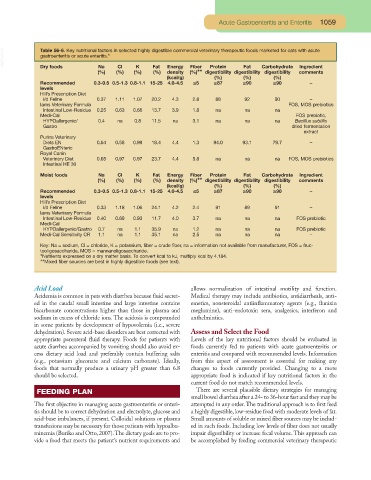Page 1020 - Small Animal Clinical Nutrition 5th Edition
P. 1020
Acute Gastroenteritis and Enteritis 1059
VetBooks.ir Table 56-6. Key nutritional factors in selected highly digestible commercial veterinary therapeutic foods marketed for cats with acute
gastroenteritis or acute enteritis.*
Dry foods
K
Na
Cl
Energy Fiber
Carbohydrate
Fat
Protein
Ingredient
(%) (%) (%) Fat density (%)** digestibility digestibility digestibility comments
(%)
(kcal/g) (%) (%) (%)
Recommended 0.3-0.5 0.5-1.3 0.8-1.1 15-25 4.0-4.5 ≤5 ≥87 ≥90 ≥90 –
levels
Hill’s Prescription Diet
i/d Feline 0.37 1.11 1.07 20.2 4.3 2.8 88 92 90 –
Iams Veterinary Formula FOS, MOS prebiotics
Intestinal Low-Residue 0.25 0.63 0.66 13.7 3.9 1.8 na na na
Medi-Cal FOS prebiotic,
HYPOallergenic/ 0.4 na 0.8 11.5 na 3.1 na na na Bacillus subtilis
Gastro dried fermentation
extract
Purina Veterinary
Diets EN 0.64 0.58 0.99 18.4 4.4 1.3 94.0 93.1 79.7 –
GastroENteric
Royal Canin
Veterinary Diet 0.65 0.97 0.97 23.7 4.4 5.8 na na na FOS, MOS prebiotics
Intestinal HE 30
Moist foods Na Cl K Fat Energy Fiber Protein Fat Carbohydrate Ingredient
(%) (%) (%) (%) density (%)** digestibility digestibility digestibility comments
(kcal/g) (%) (%) (%)
Recommended 0.3-0.5 0.5-1.3 0.8-1.1 15-25 4.0-4.5 ≤5 ≥87 ≥90 ≥90 –
levels
Hill’s Prescription Diet
i/d Feline 0.33 1.18 1.06 24.1 4.2 2.4 91 89 91 –
Iams Veterinary Formula
Intestinal Low-Residue 0.40 0.69 0.93 11.7 4.0 3.7 na na na FOS prebiotic
Medi-Cal
HYPOallergenic/Gastro 0.7 na 1.1 35.9 na 1.2 na na na FOS prebiotic
Medi-Cal Sensitivity CR 1.1 na 1.1 35.1 na 2.5 na na na –
Key: Na = sodium, Cl = chloride, K = potassium, fiber = crude fiber, na = information not available from manufacturer, FOS = fruc-
tooligosaccharide, MOS = mannanoligosaccharide.
*Nutrients expressed on a dry matter basis. To convert kcal to kJ, multiply kcal by 4.184.
**Mixed fiber sources are best in highly digestible foods (see text).
Acid Load allows normalization of intestinal motility and function.
Acidemia is common in pets with diarrhea because fluid secret- Medical therapy may include antibiotics, antidiarrheals, anti-
ed in the caudal small intestine and large intestine contains emetics, nonsteroidal antiinflammatory agents (e.g., flunixin
bicarbonate concentrations higher than those in plasma and meglumine), anti-endotoxin sera, analgesics, interferon and
sodium in excess of chloride ions. The acidosis is compounded anthelmintics.
in some patients by development of hypovolemia (i.e., severe
dehydration). Severe acid-base disorders are best corrected with Assess and Select the Food
appropriate parenteral fluid therapy. Foods for patients with Levels of the key nutritional factors should be evaluated in
acute diarrhea accompanied by vomiting should also avoid ex- foods currently fed to patients with acute gastroenteritis or
cess dietary acid load and preferably contain buffering salts enteritis and compared with recommended levels. Information
(e.g., potassium gluconate and calcium carbonate). Ideally, from this aspect of assessment is essential for making any
foods that normally produce a urinary pH greater than 6.8 changes to foods currently provided. Changing to a more
should be selected. appropriate food is indicated if key nutritional factors in the
current food do not match recommended levels.
FEEDING PLAN There are several plausible dietary strategies for managing
small bowel diarrhea after a 24- to 36-hour fast and they may be
The first objective in managing acute gastroenteritis or enteri- attempted in any order. The traditional approach is to first feed
tis should be to correct dehydration and electrolyte, glucose and a highly digestible, low-residue food with moderate levels of fat.
acid-base imbalances, if present. Colloidal solutions or plasma Small amounts of soluble or mixed fiber sources may be includ-
transfusions may be necessary for those patients with hypoalbu- ed in such foods. Including low levels of fiber does not usually
minemia (Buriko and Otto, 2007).The dietary goals are to pro- impair digestibility or increase fecal volume. This approach can
vide a food that meets the patient’s nutrient requirements and be accomplished by feeding commercial veterinary therapeutic

